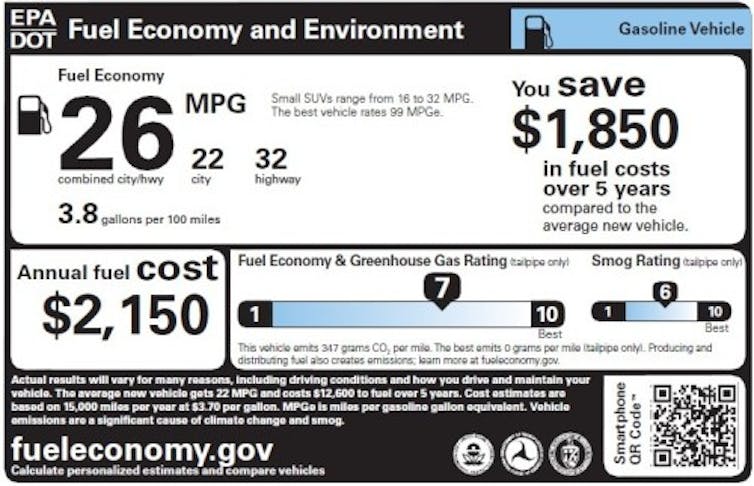Government fuel economy standards for cars and trucks have worked
- Written by James M. Sallee, Assistant Professor of Agricultural and Resource Economics, University of California, Berkeley
U.S. cars are twice as fuel-efficient today as they were 40 years ago. Corporate Average Fuel Economy (CAFE) standards are a major reason why.
These standards are in the news because the Trump administration plans to scale back increases[1] scheduled under President Barack Obama that require automakers to double fuel economy by 2025. U.S. Environmental Protection Agency Administrator Scott Pruitt now says[2] that this standard is too high.
This announcement has rightfully sparked debate – not just about narrow costs and benefits of fuel economy standards, but also over the U.S. role in shaping a global industry that faces a trio of radical transformations via electrification[3], self-driving cars[4] and ride-sharing[5].
How have CAFE standards shaped the U.S. auto market? While they are an imperfect tool, these regulations have pushed automakers to greatly increase vehicle fuel economy – and have saved consumers millions of dollars.
 Mandatory fuel economy label design adopted in 2011 for gasoline-powered vehicles.
NHTSA/EPA[6]
Mandatory fuel economy label design adopted in 2011 for gasoline-powered vehicles.
NHTSA/EPA[6]
Before Congress mandated the first CAFE standards in 1975, the average American car got about 13.5 miles per gallon[7]. By 2016, fuel economy had roughly doubled to 25 miles per gallon.
To get a sense of what that means, if Americans kept driving exactly as much as they do today but operated pre-CAFE gas guzzlers, the average U.S. household would spend nearly US$2,000 more on gasoline each year. And annual U.S. carbon dioxide emissions would jump by 1 billion tons. Economists debate[8] how much damage[9] these emissions cause, but conventional estimates peg the cost at $37 billion per year.
Does CAFE deserve credit? Yes, at least partly. Historically, the average fuel economy of vehicles in the U.S. has closely tracked[10] the minimum required by law. Fuel economy was stagnant before CAFE, then increased rapidly in lockstep with the law as CAFE standards phased in over 15 years.
When the standard sat unchanged in the 1990s, average fuel economy flatlined. Technological progress continued, but instead of designing cars that exceeded CAFE standards, auto makers made cars that were bigger[11] and faster and just met the minimum efficiency required by law. This pattern only shifted in the early 2000s, when high gasoline prices drove fuel economy gains even while CAFE was flat.
There are better ways to improve fuel economy. Many economists like me would like to replace CAFE standards[12] with a gasoline tax[13], or at least pair them with policies that target congestion and accidents. For now, however, as lawmakers debate scaling back CAFE standards, they should remember the important role these regulations have played.
References
- ^ scale back increases (theconversation.com)
- ^ says (www.epa.gov)
- ^ electrification (theconversation.com)
- ^ self-driving cars (theconversation.com)
- ^ ride-sharing (theconversation.com)
- ^ NHTSA/EPA (upload.wikimedia.org)
- ^ 13.5 miles per gallon (www.epa.gov)
- ^ debate (sites.nationalacademies.org)
- ^ damage (theconversation.com)
- ^ closely tracked (doi.org)
- ^ bigger (www.aeaweb.org)
- ^ replace CAFE standards (doi.org)
- ^ gasoline tax (energyathaas.wordpress.com)
Authors: James M. Sallee, Assistant Professor of Agricultural and Resource Economics, University of California, Berkeley
Read more http://theconversation.com/government-fuel-economy-standards-for-cars-and-trucks-have-worked-94529


